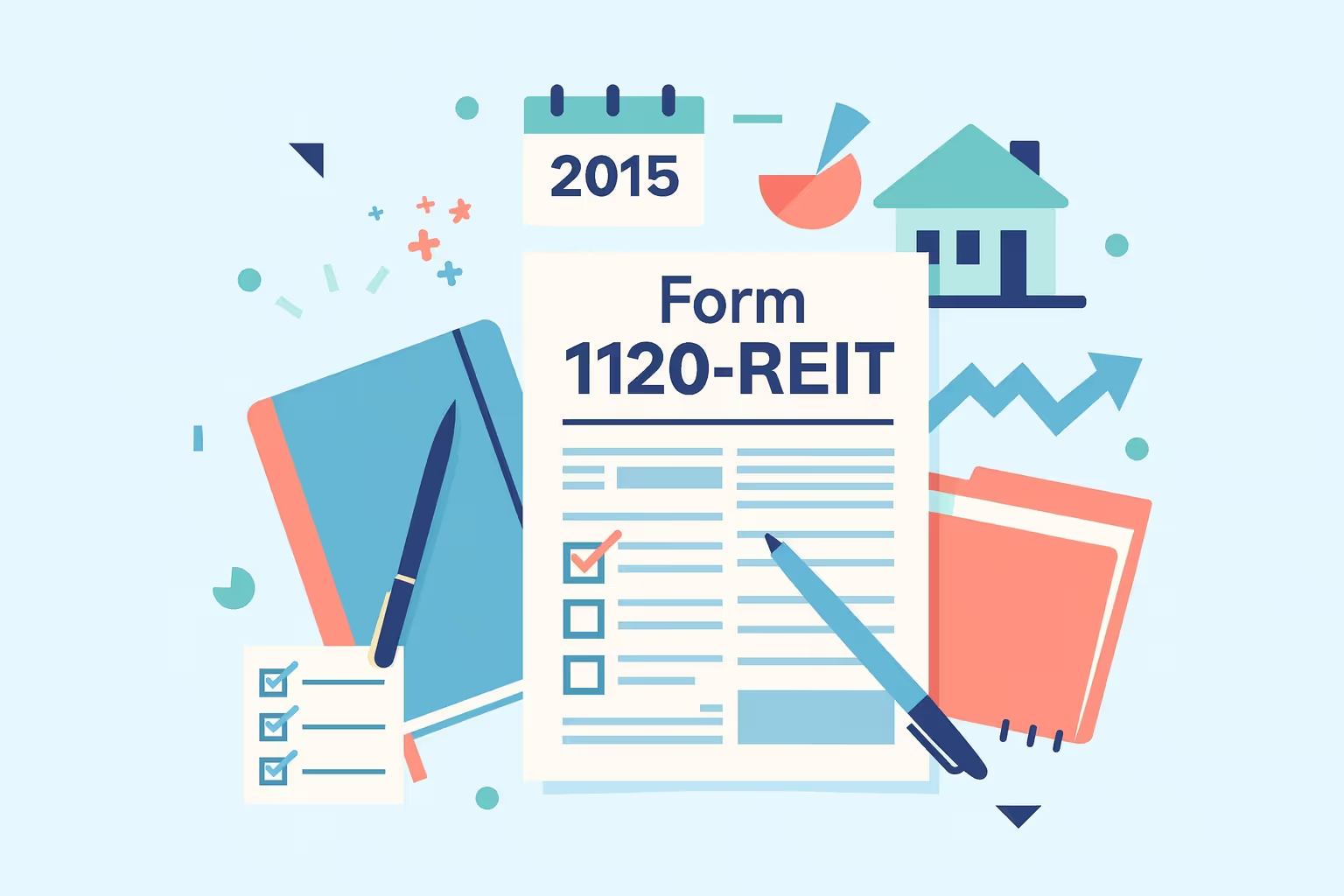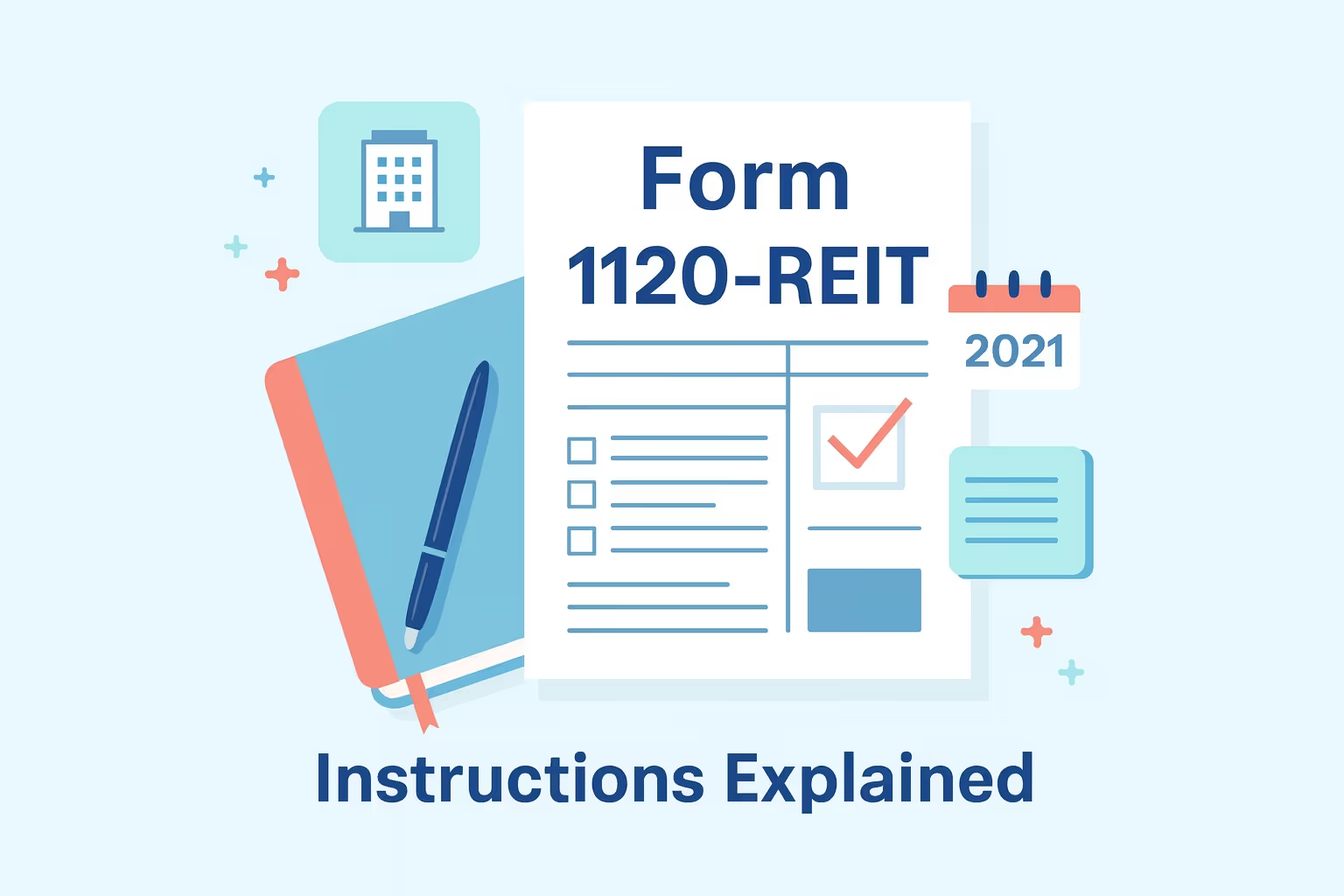Form 1120-REIT 2020 Instructions: Essential Tax Filing Guide

Filing Form 1120-REIT for the 2020 tax year can seem complex, especially for first-time taxpayers managing a Real Estate Investment Trust (REIT). This guide explains the process to help accountants, trustees, and business owners meet IRS requirements and maintain compliance under the Internal Revenue Code.
Form 1120-REIT is required for corporations, trusts, and tax-exempt organizations that elect REIT status. It reports taxable income, deductions, and shareholder distributions while verifying compliance with federal qualification rules. Filing correctly ensures the REIT can deduct dividends paid, reduce overall taxable income, and avoid penalties.
In some circumstances, even smaller REITs or educational institutions, such as schools operating real estate holdings, may be required to file. This guide is intended to provide a step-by-step roadmap—from preparing records to calculating taxes and submitting payments—so every filer can confidently complete Form 1120-REIT and preserve REIT status.
What Is Form 1120-REIT?
Form 1120-REIT is the official income tax return for Real Estate Investment Trusts (REITs) to report income, deductions, and distributions to the IRS. It confirms that the entity meets REIT qualifications under the Internal Revenue Code and allows deductions for dividends paid to avoid double taxation. Unlike standard corporate returns, it’s designed for REITs that own or finance real estate and must distribute at least 90% of taxable income annually..
This form includes several schedules that detail the REIT’s financial position and operational results:
- Part I – REIT Taxable Income: Reports total earnings and allowable deductions.
- Part II – Taxes on Special Income: Covers income from foreclosure property or prohibited transactions.
- Schedules A through M-1: Reconcile the entity's earnings, balance sheets, and other required disclosures.
For detailed filing instructions, refer to the IRS Form 1120-REIT 2020 Instructions. These official guidelines explain calculating taxable income, applying credits, and determining compliance with REIT qualification rules.
Who Must File and When
You must file Form 1120-REIT if your entity is a corporation, trust, or association elected to be treated as a Real Estate Investment Trust (REIT) and continues to meet the qualification requirements under the Internal Revenue Code. This includes organizations that receive income primarily from owning or financing real estate and distribute most of their profits to shareholders.
Filing Timeline
- Calendar Year REITs: The due date is the 15th day of the fourth month after the tax year ends, generally April 15.
- Fiscal Year REITs: If your REIT operates in a budgetary year, file it by the 15th day of the fourth month following that period.
- Extensions: You can request a six-month filing extension by submitting Form 7004, but payment deadlines remain fixed.
Penalties
Late filing or underpayment may result in interest charges and penalties. The IRS can assess 5% of unpaid tax per month, up to 25%, if the return is not filed promptly. Timely filing helps preserve your REIT’s eligibility and avoids unnecessary costs.
What’s New for Tax Year 2020
The 2020 tax year introduced several temporary provisions directly affecting Real Estate Investment Trusts (REITs). These updates, part of the federal COVID-19 relief measures, changed how certain deductions and credits were handled on Form 1120-REIT. Understanding these adjustments is essential for accurate reporting and maintaining REIT status.
Key Changes for 2020
- COVID-19 Payroll and Sick Leave Credits: Under the Families First Coronavirus Response Act (FFCRA), REITs could claim payroll tax credits for paid sick or family leave. However, any wages used for these credits must also be included as income.
- Employee Retention Credit: The CARES Act introduced this credit for qualifying wages. REITs claimed that they could not use the same salaries for multiple credits.
- Charitable Contribution Limit Increase: REITs could deduct specific cash contributions up to 25% of taxable income, exceeding the usual 10% limit.
- Business Meals Deduction: A temporary rule allowed a 100% deduction for qualified meals in 2021 and 2022.
Finally, all federal tax payments for 2020 must be made electronically through the Electronic Federal Tax Payment System (EFTPS).
Before You Start—Documents and Data Checklist
Before completing your Form 1120-REIT 2020, gather all financial and operational records needed to support your income tax return. Having complete data helps you avoid errors and ensures your REIT meets qualification and reporting standards under the Internal Revenue Code.
Essential Records
- Financial Statements: Include your general ledger, trial balance, and detailed income and expense reports.
- Shareholder Information: Maintain updated records of shareholder names, ownership percentages, and all distributions made during the calendar year.
- Property and Asset Data: Keep each real estate property's rent rolls, appraisals, and depreciation schedules.
- Subsidiary and TRS Documentation: Record any Taxable REIT Subsidiary (TRS) relationships and related transactions.
- Prior-Year Returns and Supporting Forms: Reference the previous tax return to ensure consistency and accuracy.
Accurate documentation helps confirm compliance, supports deductions, and protects your REIT in the event of an IRS inquiry or audit.
Step-by-Step Filing Instructions
Filing Form 1120-REIT for the 2020 tax year requires attention to detail and proper documentation. Each section of the form serves a specific purpose in confirming your REIT’s status, reporting taxable income, and demonstrating compliance with the Internal Revenue Code. The steps below outline how to accurately prepare and complete your income tax return.
Step 1 — Confirm REIT Election and Filing Requirement
Before filing, verify that your corporation, trust, or association has properly elected to be treated as a Real Estate Investment Trust (REIT). The election is demonstrated each year through the filing of Form 1120-REIT. If the entity no longer meets the qualification tests under the Code, it may lose its tax-exempt treatment on distributed earnings.
Step 2 — Complete the Return Header
Provide complete identification details when filling out Form 1120-REIT:
- REIT Information: Enter the REIT’s full legal name, mailing address, and Employer Identification Number (EIN) as registered with the IRS.
- Tax Year: Indicate whether the filing covers a calendar year or a specific fiscal period, ensuring the dates match your accounting records.
- REIT Type: Specify the classification of your entity as either an Equity REIT or a Mortgage REIT, depending on its primary business activities.
- Subsidiaries: List any subsidiaries your REIT owns, but do not check the box for Taxable REIT Subsidiaries (TRS). These separate tax-paying entities must file their own income tax returns independently.
Step 3 — Report Income (Part I, Lines 1–8)
Report all income sources accurately:
- Rents from real property should include gross amounts received before deductions.
- Interest income covers mortgage and other qualifying interest.
- Dividend income should reflect amounts from investments and other REITs.
- Capital gains are reported from sales or exchanges of real property or securities.
- Include foreclosure property and other income, such as Section 481(a) adjustments.
Maintain detailed records that support each reported amount in case of IRS review.
Step 4 — Claim Deductions (Part I, Lines 9–22)
List allowable deductions in this section, including wages, repairs, taxes, interest, depreciation, and bad debts. The deduction for dividends paid is significant, as it typically represents the largest deduction for REITs. This deduction allows the REIT to reduce taxable income by the amount distributed to shareholders, provided it meets all timing and qualification requirements.
Step 5 — Apply Qualification Tests Within the Return Flow
REITs must meet several ongoing tests to retain tax benefits:
- Distribution Test (90%): At least 90% of REIT taxable income (before the dividends paid deduction) must be distributed to shareholders.
- Income Tests (95% and 75%): Ensure that the proper percentage of income comes from qualifying sources, such as real estate rent, mortgage interest, and capital gains.
- Asset Tests: Verify that the REIT’s holdings comply with ownership and diversification requirements each quarter.
Step 6 — Complete Required Schedules
- Schedule A – Deduction for Dividends Paid
- Schedule J – Tax computation and credit calculations
- Schedule K – Other information, including foreign ownership and compliance questions
- Schedule L – Balance sheets showing beginning and end-of-year totals
- Schedule M-1 – Reconciliation of book income to taxable income
Attach additional schedules such as Forms 8612, 2438, or 2439 when applicable.
Step 7 — Compute Tax, Credits, and Payments
Calculate the final tax liability after applying credits and prior tax payments. REITs may owe a 4% excise tax on undistributed income, computed on Form 8612. Confirm that estimated payments match EFTPS records. If you expect a refund, decide whether to apply it toward next year’s estimated tax or request it directly.
Step 8 — Assemble, Review, and Sign
Review all figures for accuracy. Assemble attachments in the IRS-specified order, include the REIT’s name and EIN on every document, and obtain an authorized signature. File the return by April 15 (for calendar-year REITs) or by the 15th day of the fourth month after your fiscal year ends. To avoid penalties, file on time or request an extension using Form 7004. Late submissions may result in additional interest, loss of credits, or risk to REIT qualification.
REIT Qualification Tests Explained
To maintain REIT status and qualify for special tax treatment under the Internal Revenue Code, a Real Estate Investment Trust must meet several ongoing annual tests. These tests confirm that most of the REIT’s income, assets, and distributions come from eligible real estate activities. Failure to meet any test can lead to tax penalties or the loss of REIT classification.
Income Tests (95% and 75%)
REITs must meet two separate income thresholds annually:
- 95% Test: At least 95% of gross income must come from passive sources such as rents from real property, interest on mortgages, and dividends from other REITs.
- 75% Test: At least 75% of gross income must come specifically from real estate–related sources, including rental income, mortgage interest, and capital gains from the sale of real property.
REITs that fail an income test due to reasonable cause may request relief under a revenue procedure, provided corrective actions and tax payments are made promptly.
Asset Tests (75%, 25%, 5%, and 10%)
Each quarter, a REIT must test its asset composition to ensure proper diversification:
- 75% Test: At least 75% of total assets must be real estate, cash, or government securities.
- 25% Limit: No more than 25% of total assets may be invested in securities of Taxable REIT Subsidiaries (TRS) or other non-qualifying assets.
- 5% and 10% Limits: A REIT cannot own more than 5% of the value or 10% of the voting power of any one issuer, except for other REITs or government securities.
These rules prevent excessive risk concentration and help demonstrate that the REIT’s assets primarily support real estate operations.
Distribution Requirement (90%)
To maintain REIT status, the entity must distribute at least 90% of its taxable income—excluding capital gains—to shareholders each year. This ensures most earnings pass to investors instead of being taxed corporately. Distributions can be in cash or stock but must follow IRS timing rules. Ongoing income, assets, and payout tracking throughout the calendar year preserves compliance and REIT tax benefits.
Required Schedules, Forms, and Attachments
When completing Form 1120-REIT, supporting schedules and attachments help the IRS verify your income tax return and confirm that your Real Estate Investment Trust meets all filing requirements under the Internal Revenue Code. Each schedule serves a distinct purpose, documenting your REIT’s income, deductions, and overall financial position.
Always Required Schedules
- Schedule A – Deduction for Dividends Paid: Lists all shareholder distributions and calculates the deduction used to reduce taxable income.
- Schedule J – Tax Computation: Calculates total income tax, applicable credits, and payments made during the year.
- Schedule K – Other Information: Includes compliance questions about ownership, foreign accounts, and prohibited transactions.
- Schedule L – Balance Sheets per Books: Reports beginning and end-of-year asset and liability balances.
- Schedule M-1 – Reconciliation of Income: Explains any differences between book and taxable income for the IRS.
Conditionally Required Forms
Depending on your REIT’s operations, additional IRS forms may be required to complete a compliant filing:
- Form 8612: Calculates and reports the 4% excise tax on undistributed income when required distributions aren’t made by year-end. Filing ensures compliance with IRS rules and prevents penalties.
- Forms 2438 and 2439: Used to report undistributed capital gains or notify shareholders of their taxable profit share. Proper filing helps investors report these gains on personal returns.
- Forms 8875, 5471, 8865, or 976: Required for TRS elections, foreign ownership disclosures, or deficiency dividend reporting.
Attach supporting documents—property schedules, depreciation records, and distribution worksheets—with the REIT’s name and EIN clearly listed.
How to File—Paper vs. E-File and Payments
Form 1120-REIT may be filed on paper or electronically, though e-filing is preferred for speed, security, and accuracy. The IRS provides guidance to prevent filing errors.
Paper Filing
When filing by paper:
- Mailing Address: Send your return to the correct IRS service center based on your principal place of business and total amount of assets.
- Filing Order: Arrange schedules and attachments in the sequence shown in the instructions, and include the REIT’s name and Employer Identification Number (EIN) on each page.
- Deadline: File by the last day of the fourth month following your tax year’s close. For example, a REIT operating on a calendar year must file by April 15.
- Additional Information: Attach supporting schedules, statements, or elections as required under the Internal Revenue Code.
Electronic Filing
Most filers plan to submit electronically through the IRS system for faster confirmation and more accurate data transmission. E-filing also streamlines payment processing and helps maintain consistent company earnings reporting.
- Eligibility: Both domestic and international filers may e-file. Persons serving in the Armed Forces outside the United States may qualify for an automatic extension.
- Records: Keep confirmation notices and transmitted data copies for at least one year.
Payments
All tax payments must be made through the Electronic Federal Tax Payment System (EFTPS).
- Schedule payments early, especially for estimated amounts due in the second quarter.
- Ensure beneficiaries and related persons tied to the REIT know their reporting obligations.
- Proper timing and documentation help ensure distributions remain tax-free to the extent permitted by law and prevent penalties for late or missing payments.
Estimated Taxes, Extensions, and Deadlines
Proper planning protects your REIT’s earnings and ensures compliance with IRS rules. REITs expecting to owe at least $500 in annual tax are subject to quarterly estimated tax payments.
- Estimated Payments:
- Each installment should equal 25% of the estimated total tax due for the year.
- Payments are generally due on the 15th day of the tax year's fourth, sixth, ninth, and twelfth months.
- Pursuant to IRS regulations, late or insufficient payments may lead to penalties or interest charges.
- Each installment should equal 25% of the estimated total tax due for the year.
- Extension Requests:
- File Form 7004 before the original due date to request more time to file.
- The extension only delays the filing deadline, not the payment date. REITs must perform timely transfers as scheduled.
- File Form 7004 before the original due date to request more time to file.
- Planning Tips:
- In the normal course of business, withdraw funds early to cover payments.
- Filing on time respects IRS procedures and maintains compliance to the highest degree.
- Coordinate with your tax team to verify payments and avoid missed installments.
- In the normal course of business, withdraw funds early to cover payments.
Common Errors and How to Fix Them
Filing an accurate income tax return for Real Estate Investment Trusts (REITs) is essential to maintain compliance and avoid penalties. Even small mistakes can delay processing or result in costly corrections. The following points highlight common issues and practical ways to prevent them.
Missing or Incorrect Information on the Tax Return
Incorrect details often lead to rejections. Verify the REIT’s name, address, and Employer Identification Number (EIN). Confirm that the filing period matches the calendar or fiscal year, and cross-check figures with financial statements.
Unsupported Deductions on a Real Estate Investment Trust's Filing
Deductions for distributions, depreciation, or interest must be accurate. Keep supporting documentation for at least one year to meet IRS recordkeeping requirements.
Qualification Test Failures for Real Estate Investment Trusts
Failing to meet income or asset tests can jeopardize REIT status. Review quarterly results to ensure compliance and track shareholder distributions throughout the year.
Late Filing or Payment of Income Tax
Deadlines for REITs are strict and treated as time-sensitive actions. File electronically whenever possible to confirm receipt. Missing due dates for income tax filings may lead to penalties or loss of benefits. Thorough preparation and timely filing help ensure accuracy and preserve your REIT’s standing with the IRS.
Exceptional Cases — Dormant and First-Year REITs
Certain Real Estate Investment Trusts (REITs) face unique filing situations, primarily when they are newly formed or experience little to no activity during the tax year. Understanding how to handle these cases ensures continued compliance with the Internal Revenue Code and preserves REIT status.
Dormant or Minimal-Activity REITs
Even if your REIT had no income or operations, you must still file Form 1120-REIT to maintain the election and confirm ongoing qualification.
- Report zero or minimal income, but complete all required schedules.
- Continue to meet ownership and asset tests to show compliance.
- Keep accurate records of assets, shareholder information, and distributions, even if none were made.
Filing a return during a dormant period helps avoid termination of REIT status and potential penalties for noncompliance.
First-Year REITs
Newly elected REITs often face additional documentation and testing requirements.
- Establish that the REIT was formed correctly and elected under the correct provisions.
- Satisfy ownership and organizational tests from the first day of the election year.
New REITs are not required to meet the 100-shareholder rule until their second year. - Develop a compliance plan early to manage distributions and testing deadlines.
Proper filing during dormant and first-year periods ensures the REIT remains qualified and compliant.
Recordkeeping and Compliance Calendar
Strong recordkeeping ensures accurate filings and preserves your REIT’s compliance with the Internal Revenue Code. Keeping well-organized records for income, expenses, and distributions helps demonstrate continued eligibility for REIT status and supports transparency during audits or reviews.
Key Recordkeeping Practices
REITs should maintain detailed and secure records for all financial activities. They should keep tax returns, schedules, and supporting documents for at least three years. Permanent records—such as property basis information, shareholder ownership details, and significant transactions—should be retained indefinitely. Both digital and physical copies must be stored safely for easy access when needed.
Compliance Calendar
A structured compliance calendar helps REITs meet essential tax and reporting deadlines. Review income and asset tests quarterly to verify qualification. Plan distributions before year-end to satisfy the 90% requirement and schedule estimated tax payments throughout the calendar year. Consistent tracking ensures timely filings and safeguards your REIT’s good standing with the IRS.
Conclusion
Filing Form 1120-REIT requires accuracy, organization, and awareness of all compliance requirements under the Internal Revenue Code. Your REIT can preserve its favorable tax treatment and avoid unnecessary penalties by maintaining proper documentation, meeting qualification tests, and planning timely distributions.
Regular review of deadlines and recordkeeping practices supports smooth filing each year. When in doubt, seek guidance from a qualified tax professional to ensure your REIT remains compliant and efficient in managing its obligations.
Frequently Asked Questions (FAQs)
What is Form 1120-REIT, and how is it used?
Form 1120-REIT is the annual federal income tax return that Real Estate Investment Trusts must file to report income, deductions, and compliance with qualification requirements. It serves as both a tax return and proof that the REIT meets all necessary standards under the Internal Revenue Code. Filing accurately annually ensures continued eligibility for special tax treatment and helps the REIT maintain its compliance status.
Can I file Form 1120-REIT without a separate election form?
Submitting Form 1120-REIT is considered the official election to be treated as a Real Estate Investment Trust. No additional election form is needed. However, the entity must meet ownership, income, and structural qualifications during its first filing year and continue to meet these standards annually. Failure to do so may cause the REIT to lose its favorable tax status and face standard corporate taxation.
How do the 75% and 95% income tests differ?
The 75% test ensures that most of the REIT’s income comes from real estate sources, such as rent, mortgage interest, and property sales. The 95% test allows for a broader qualifying income range, including dividends and capital gains. Both tests must be met annually to retain REIT status and avoid penalties under the Internal Revenue Code for noncompliance or disqualification.
How is the 90% distribution requirement calculated and timed?
To maintain REIT qualification, a trust must distribute at least 90% of its taxable income to shareholders before the dividends paid deduction. These distributions must be made during the tax year or by the extended filing deadline. Meeting this rule allows the REIT to claim the dividends-paid deduction and avoid corporate-level taxation on distributed income, preserving the benefits of REIT status.























